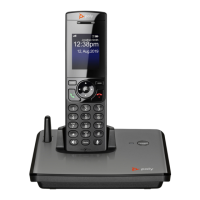Service Providers
46
device is online and functional. Each device takes only one local IP address that is either statically assigned
in the device’s configuration, or dynamically obtained from a local DHCP server. The SPn services (for n =
1 through 8) each use a different local contact port for sending and receiving SIP messages (defaults are
5060, 5061, 5062, and 5063).
Note that dynamic address binding through periodic registration isn’t strictly necessary if the local IP address
of the device doesn’t change. The device’s contact address can be statically configured on the Registration
Server.
SIP Outbound Proxy Server
An outbound proxy server can be configured on the device such that all outbound requests are sent via the
outbound proxy server instead of directly to the SIP Proxy Server or Registration Server.
If the outbound proxy server is listening at a non-standard port, the correct port value must be specified in
the OutboundProxyPort parameter. The OutboundProxy can use a different transport protocol from the
ProxyServer. The transport protocol to use to communicate with the OutboundProxy can be set in the
OutboundProxyTransport parameters. If OutboundProxyTransport is TCP or TLS, your device initiates
a TCP or TLS connection only with the OutboundProxy. All subsequent messages exchanged between
your device and the servers MUST use the same connection. If for any reason the connection is closed,
your device attempts to re-establish the connection with the OutboundProxy following an exponential
back-off retry pattern.
Even though your device only exchanges messages directly with the OutboundProxy, the ProxyServer,
ProxyServerPort, and ProxyServerTransport parameters are still very much relevant and important since
the SIP requests sent by your handset to the server are formed based on these values, not based on the
OutboundProxy value. The OutboundProxy value should never appear in the SIP requests generated by
your device, unless the OutboundProxy parameter has the same value as ProxyServer.
Some server implementations include the outbound proxy server in a Record-Route header such that your
device should not respect the locally configured OutboundProxy value after the initial INVITE is sent for a
new call. This behavior can be achieved by enabling the ITSP Profile X –
SIP::X_BypassOutboundProxyInCall option. However, this option has no effect when the
OutboundProxyTransport is TCP or TLS, as your device always uses the same connection to send
messages to the server.
DNS Lookup of SIP Servers
When sending out SIP requests to the server, the device looks up the IP address of the server using
standard DNS query if the server is specified as a domain name instead of an IP address. If an Outbound
Proxy Server is configured, it’s used instead of the SIP Proxy Server or SIP Registration Server. The
resolution of the server domain name into IP address is performed in the following manner:
● Try looking up the name as DNS A Record. If not found,
● Try looking up the name as DNS SRV Record. If not found,
● Try looking up the name as DNS SRV Record with “_sip._udp.“ prepended to the host name. If not
found, fail the request.
If the result from the DNS query is an SRV record, the server port is taken from that record also. The server
port value configured on the device is ignored. Otherwise, the server port is taken from the configured value
or uses port 5060 if none is specified.

